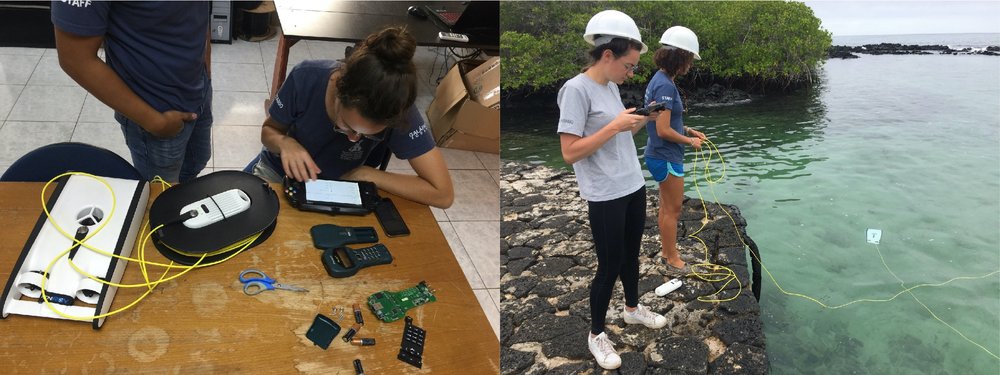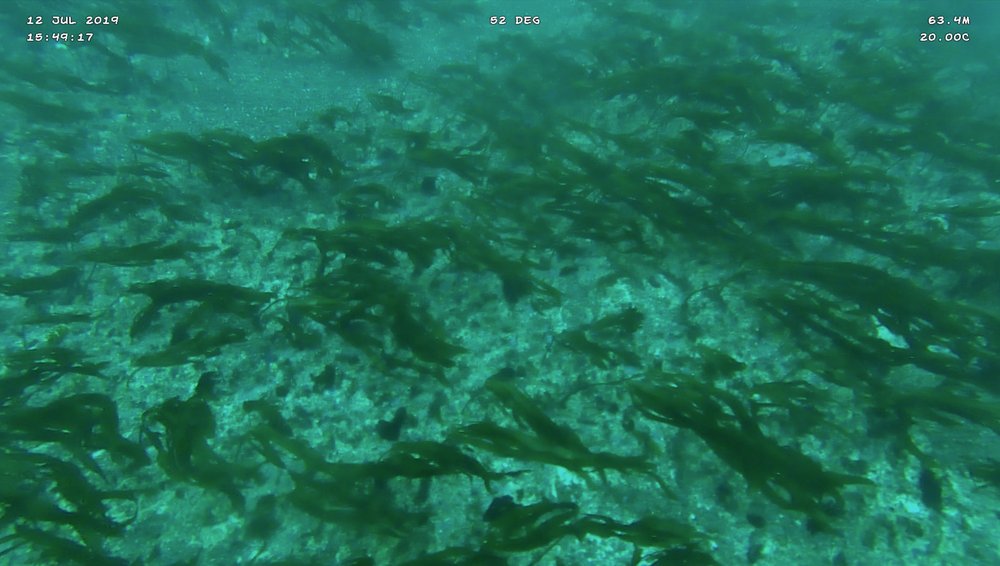Beautiful images of rarely seen sea-floor creatures are surfacing from the mesophotic or the “twilight” zone of Galapagos Marine Reserve (GMR). To explore this low-light zone between 40m to 150m, we at the Seamount Research Project from the Charles Darwin Foundation are now utilizing a new generation of small remotely operated vehicles (ROV). Sofar and National GeographicGeographic generously donated one of their Trident ROVs to us, which is an easy to use “aquatic drone” piloted using a video game controller. This ROV is allowing us to investigate a part of the GMR that remains almost entirely unexplored.
Getting ready for the first field trip!

Before testing it in open ocean, we practiced operating the ROV from the pier of the research station. On the screen of the controller we were able to observe many iconic species, including yellowtail damselfish, and a feeding spotted eagle ray.

The eagle ray was unfazed by the presence of the ROV, as it continued to forage the seabed, using its elongated snout to sift through the fine sand in search of mollusks and crustaceans. In these calm waters, the ROV proved to be highly maneuverable and after enough practice, it was time to take it into deep water for its first real mission.
Our expectations and the first trip of the Trident ROV
Last year CDF’s senior scientist, Salome Buglass, discovered an unknown species of deep-water kelp in GMR, on the summit of a shallow seamount between depths of 40-80m. With the help of the Trident ROV, we hoped to find more.
“I’m very keen to take our mini ROV into deep waters on any occasion possible, as I think there are likely many deep water kelp forests out there, as well as other productive habitats, awaiting to be uncovered” said CDF’s senior scientist Salome Buglass.
Our first exploration site was off Santa Fe Island, where our skipper, a local fisherman, had encountered deep-sea kelp once before on his fishing lines. We lowered the ROV into the high seas, and it began its descent. As it propelled down, the light began to fade, and at 70m the tether connected to the ROV was almost spent. Steering the ROV from a moving vessel, in rough seas and strong currents, was far more challenging than in the shallows, and required help from all hands-on deck.
What did we find?
Below, the Trident’s torch illuminated a school of whitefish (Blanquillo), seemingly curious about their conspicuous visitor. On our video stream at the surface, we could see strange mottled shapes with brilliant colors forming on the seabed. Excited, albeit quite queasy, we realized we had landed on a beautiful mesophotic coral garden.

Most of the soft corals look like they belong to the genus Muricea, but we were uncertain about one species, until expert taxonomist Stephen Cairns, on one occasion helped us identify it from images taken by the Trident.
“The color and depth match Stylaster marenzelleri (Cairns, 1986)” says Stephen Cairns of the Smithstonian Institution on the ID of the bright pink hydroid in the center of the images.

Our team was also extremely excited when later in the day, at a depth of 63m we finally found kelp beds confirming that there are likely a lot more of these macro-alga habitats across the twilight zone depths of the archipelago. All in all, our first deep water mission with the new ROV was a total success. Our fascinating findings really show the value of these new research tools, but more importantly how little we know about life in the deep water of our oceans, and that there is probably so much more to be discovered.






